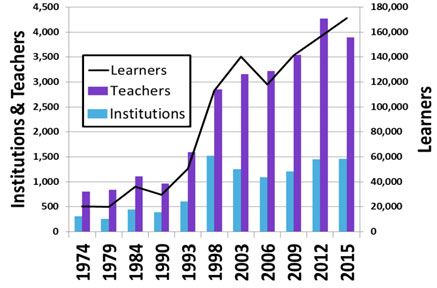

by Amanda Rollins, Japanese Language Program Coordinator
The Japan Foundation is the only organization that gathers nationwide data on Japanese language teaching in the United States at all levels of education. We use the data to decide regional grant allocations, to create new support programs, and to spread awareness about our resources. But you can use the data too! Our Tokyo Headquarters maintains a free, online database of every school that answered our survey. The 2015 results will be entered into the database in early 2017.
 The JF Survey 2015 Report: U.S. Data was released last week, and the global results will be released soon at the JF Headquarters website. Clearly, the most noteworthy piece of information is that the number of people teaching Japanese has declined for the first time since 1990. This corresponds to a national teacher shortage that the U.S. is experiencing across many school subjects.
The JF Survey 2015 Report: U.S. Data was released last week, and the global results will be released soon at the JF Headquarters website. Clearly, the most noteworthy piece of information is that the number of people teaching Japanese has declined for the first time since 1990. This corresponds to a national teacher shortage that the U.S. is experiencing across many school subjects.
It is also possible that the teachers who began teaching Japanese in the 90s due to Japan’s economic boom are now entering retirement. And according to a recent U.S. Department of Education Office of Postsecondary Education publication, Teacher Preparation Program enrollment is declining even while overall K-12 student enrollment is increasing. This could mean that the new generation of Japanese language teachers is not robust.
So what should we, as a community, do about this? As individuals, we can do several things: Encourage our students to become passionate and skilled teachers, connect potential teachers to organizations that provide information and networking opportunities, and reach out to new teachers to give mentoring and support. Please feel free to use the JF Survey database to reach out.
And it’s good to remember that we have reason to be optimistic. In our survey, more institutions stated that they expect enrollment to increase rather than decrease in three years, across all levels of education.